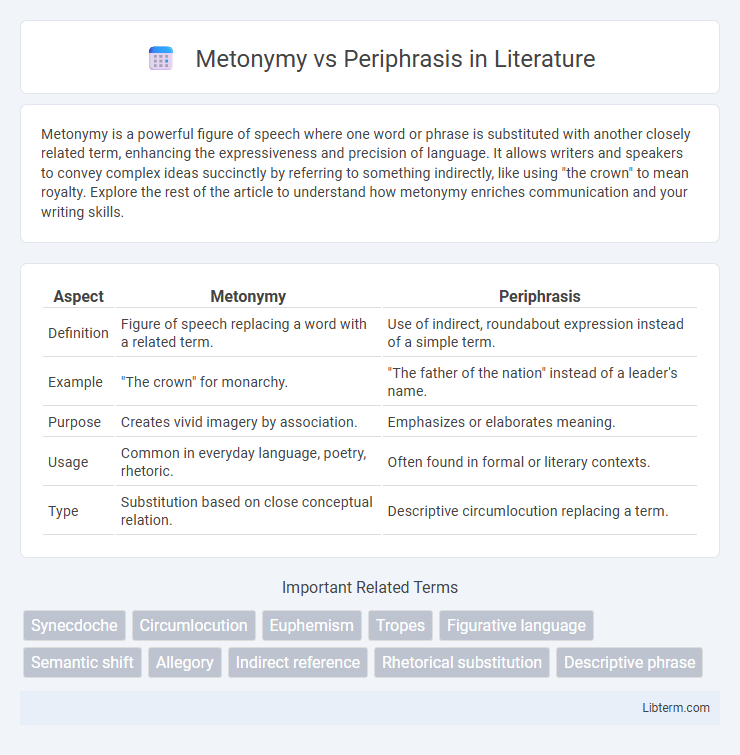Metonymy is a powerful figure of speech where one word or phrase is substituted with another closely related term, enhancing the expressiveness and precision of language. It allows writers and speakers to convey complex ideas succinctly by referring to something indirectly, like using "the crown" to mean royalty. Explore the rest of the article to understand how metonymy enriches communication and your writing skills.
Table of Comparison
| Aspect | Metonymy | Periphrasis |
|---|---|---|
| Definition | Figure of speech replacing a word with a related term. | Use of indirect, roundabout expression instead of a simple term. |
| Example | "The crown" for monarchy. | "The father of the nation" instead of a leader's name. |
| Purpose | Creates vivid imagery by association. | Emphasizes or elaborates meaning. |
| Usage | Common in everyday language, poetry, rhetoric. | Often found in formal or literary contexts. |
| Type | Substitution based on close conceptual relation. | Descriptive circumlocution replacing a term. |
Introduction to Metonymy and Periphrasis
Metonymy involves substituting a word with another closely related term, such as "the crown" representing royalty, emphasizing a direct association between concepts. Periphrasis uses a descriptive phrase instead of a single word to express an idea, often enhancing clarity or emphasis, like saying "the father of modern physics" instead of "Einstein." Understanding the nuances between metonymy and periphrasis reveals how language can convey meaning succinctly or elaborately through associative or circumlocutory expressions.
Defining Metonymy: Key Features
Metonymy is a figure of speech where a word or phrase is substituted with another closely related term, such as "the crown" representing royalty or authority. This semantic shift relies on a contextual association rather than a direct likeness, distinguishing it from metaphor. Key features include the use of tangible or familiar objects to signify abstract concepts, creating concise and impactful expressions in language.
Defining Periphrasis: Essential Characteristics
Periphrasis is a rhetorical device characterized by the use of indirect, longer expressions instead of concise terms, often to enhance clarity, formality, or emphasis. It involves substituting a simple word with a descriptive phrase, such as saying "the crown" instead of "the king," which also overlaps with metonymy but prioritizes circumlocution. Essential characteristics of periphrasis include its function to elaborate meaning through extended phrasing, stylistic variation, and the ability to avoid repetition or ambiguity in language.
Historical Origins and Evolution
Metonymy traces its origins to ancient Greek rhetoric, where it was employed as a concise way to substitute a word with another closely related to its meaning, evolving into a fundamental figure of speech in both classical and modern literature. Periphrasis, also rooted in classical rhetoric, emerged as an elaborate descriptive device, offering circumlocutory expressions that enriched linguistic style and clarity across evolving languages and genres. Both devices evolved through centuries of literary and spoken traditions, influencing linguistic creativity by enabling nuanced expression tied to cultural and contextual shifts.
Linguistic Functions and Purposes
Metonymy functions as a linguistic device that substitutes a word with another closely related term to convey meaning efficiently, enhancing figurative expression and cognitive connections in communication. Periphrasis employs descriptive phrases instead of single words to add emphasis, clarity, or politeness, enriching language style and nuance. Both devices serve different purposes in rhetoric: metonymy condenses meaning through association, while periphrasis expands description for emphasis or stylistic effect.
Differences Between Metonymy and Periphrasis
Metonymy involves substituting a word with another closely related term, such as "the crown" representing royalty, whereas periphrasis uses descriptive phrases to express an idea indirectly, like saying "the ruler of the United Kingdom" instead of "the king." Metonymy relies on a direct association or contiguity between concepts, while periphrasis employs circumlocution and elaboration to convey meaning. The primary difference lies in metonymy's use of related shorthand terms compared to periphrasis's preference for longer, explanatory expressions.
Metonymy and Periphrasis in Literature
Metonymy in literature involves substituting a word with another closely related term, such as using "the crown" to represent royalty, enhancing symbolic depth and thematic resonance. Periphrasis employs descriptive phrases to replace simple terms, adding stylistic complexity and evoking vivid imagery, like calling death "the final sleep." Both devices enrich literary texts by creating layers of meaning and engaging readers through indirect expression.
Common Examples in Everyday Language
Metonymy commonly appears in phrases like "The White House announced" where "The White House" represents the U.S. president or administration, and "Hollywood" refers to the American film industry. Periphrasis is evident in expressions such as "the city that never sleeps" for New York City or "the crown" used to describe the monarchy, emphasizing descriptive or indirect naming. These devices enrich everyday communication by substituting direct terms with symbolic or elaborate descriptors that convey deeper meaning or cultural context.
Effects on Tone and Style
Metonymy enhances tone by creating vivid, concise imagery through the substitution of related words, adding directness and intensity to the style. Periphrasis, by using indirect or roundabout expressions, introduces ambiguity and formality, often softening the tone and creating a more elaborate or ornate style. The choice between metonymy and periphrasis significantly influences the reader's perception, either sharpening the message or enriching the linguistic texture.
Conclusion: Choosing Between Metonymy and Periphrasis
Choosing between metonymy and periphrasis depends on the desired communicative effect and context clarity. Metonymy employs a single related term to evoke a concept succinctly, enhancing vividness and symbolic depth in language. Periphrasis uses indirect, descriptive phrases to clarify or emphasize meaning, often providing more explicit detail but sacrificing brevity.
Metonymy Infographic

 libterm.com
libterm.com